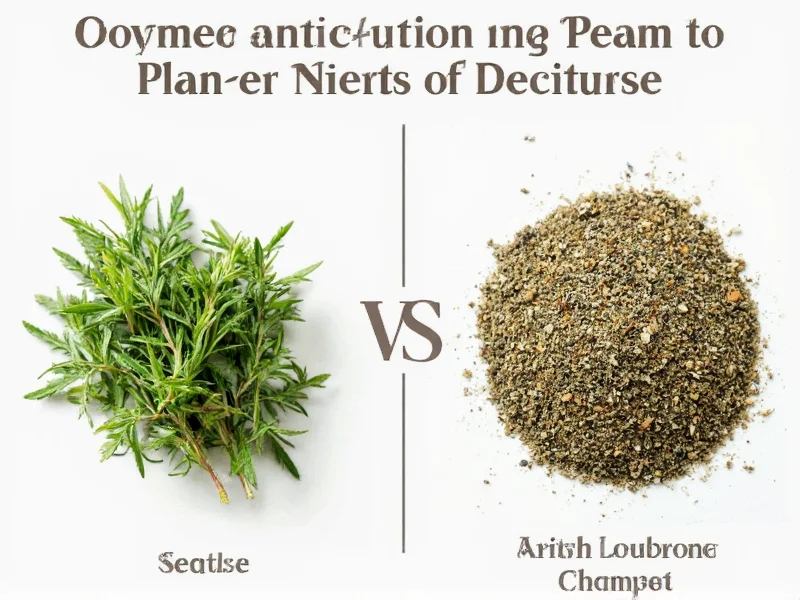Understanding fresh vs dried thyme conversion is essential for home cooks and professional chefs alike. Thyme, whether fresh or dried, adds distinctive earthy, slightly minty notes to dishes, but their flavor intensities differ significantly due to the drying process.
Why Fresh and Dried Thyme Require Conversion
When herbs dry, they lose moisture but retain most flavor compounds, resulting in more concentrated potency. Fresh thyme contains approximately 85% water, while dried thyme has only about 10% moisture content. This dramatic reduction means dried thyme delivers more intense flavor per volume.
The 3:1 conversion ratio (fresh to dried) isn't arbitrary—it reflects the actual concentration difference. Dried thyme typically contains three times the flavor compounds by volume compared to fresh. Using equal amounts would result in either a weak flavor (when substituting dried for fresh) or an overpowering herbal taste (when using fresh instead of dried).
Practical Fresh vs Dried Thyme Conversion Chart
| Dried Thyme | Fresh Thyme Equivalent | Best For |
|---|---|---|
| ¼ teaspoon | ¾ teaspoon chopped | Delicate sauces, dressings|
| ½ teaspoon | 1½ teaspoons chopped | Soups, stews, braises|
| 1 teaspoon | 1 tablespoon chopped | Roasts, marinades, hearty dishes|
| 1½ teaspoons | 4½ teaspoons chopped | Long-cooking dishes|
| 1 tablespoon | 3 tablespoons chopped | Intense flavor applications
When to Use Fresh vs Dried Thyme
Each form offers unique advantages depending on your cooking application:
Fresh Thyme Best Uses
- Finishing dishes where bright, grassy notes enhance final presentation
- Delicate preparations like salad dressings and seafood dishes
- When visual appeal matters (whole sprigs make attractive garnishes)
- Short-cooking recipes where dried herbs wouldn't have time to rehydrate
Dried Thyme Best Uses
- Long-simmering dishes like stews, soups, and braises
- Rub mixes for meats where consistent texture matters
- Baked goods and breads requiring even distribution
- Situations where shelf stability is important
Proper Measurement Techniques
Accurate measurement affects your fresh to dried thyme substitution success:
For fresh thyme: Strip leaves from stems before measuring, then gently pack into measuring spoons without compressing. One sprig of fresh thyme typically yields ½ to 1 teaspoon of leaves.
For dried thyme: Spoon lightly into measuring spoons and level off—don't pack unless recipe specifically instructs. Dried thyme compacts easily, which can lead to overuse if not careful.
Storage Guidelines for Maximum Freshness
Proper storage extends the usable life of both forms:
Fresh thyme: Store upright in a glass with 1 inch of water (like flowers), covered loosely with a plastic bag in the refrigerator. Properly stored, fresh thyme maintains quality for 10-14 days. Alternatively, wrap in slightly damp paper towels inside a perforated plastic bag.
Dried thyme: Keep in airtight containers away from light, heat, and moisture. Properly stored dried thyme retains optimal flavor for 1-2 years. Test potency by rubbing and smelling—strong aroma indicates freshness.
Common Fresh vs Dried Thyme Conversion Mistakes
Avoid these frequent errors when substituting between fresh and dried thyme:
- Equal substitution: Using 1:1 ratio makes dishes either too weak or overwhelmingly herbal
- Ignoring cooking time: Adding dried thyme to quick-cooking dishes without rehydrating first
- Overpacking dried thyme: Compacting dried thyme in measuring spoons doubles intended quantity
- Using stems in measurements: Counting whole sprigs rather than just the leaves
- Not adjusting for age: Older dried thyme loses potency, requiring slightly more than standard conversion
Professional Chef Tips for Thyme Conversion
Seasoned cooks employ these techniques for perfect thyme integration:
When substituting dried for fresh in long-cooking dishes, add dried thyme early to allow rehydration. For quick-cooking applications, briefly soak dried thyme in warm broth or water before adding to prevent bitter notes.
Remember that dried thyme's flavor develops more slowly than fresh. In dishes with short cooking times, increase dried thyme quantity by 25% and add it at the beginning rather than the end of cooking.
For the most accurate fresh thyme to dried thyme ratio in critical recipes, taste as you go. Start with the standard 3:1 ratio, then adjust after 10-15 minutes of cooking to account for variables like thyme variety and freshness.











 浙公网安备
33010002000092号
浙公网安备
33010002000092号 浙B2-20120091-4
浙B2-20120091-4